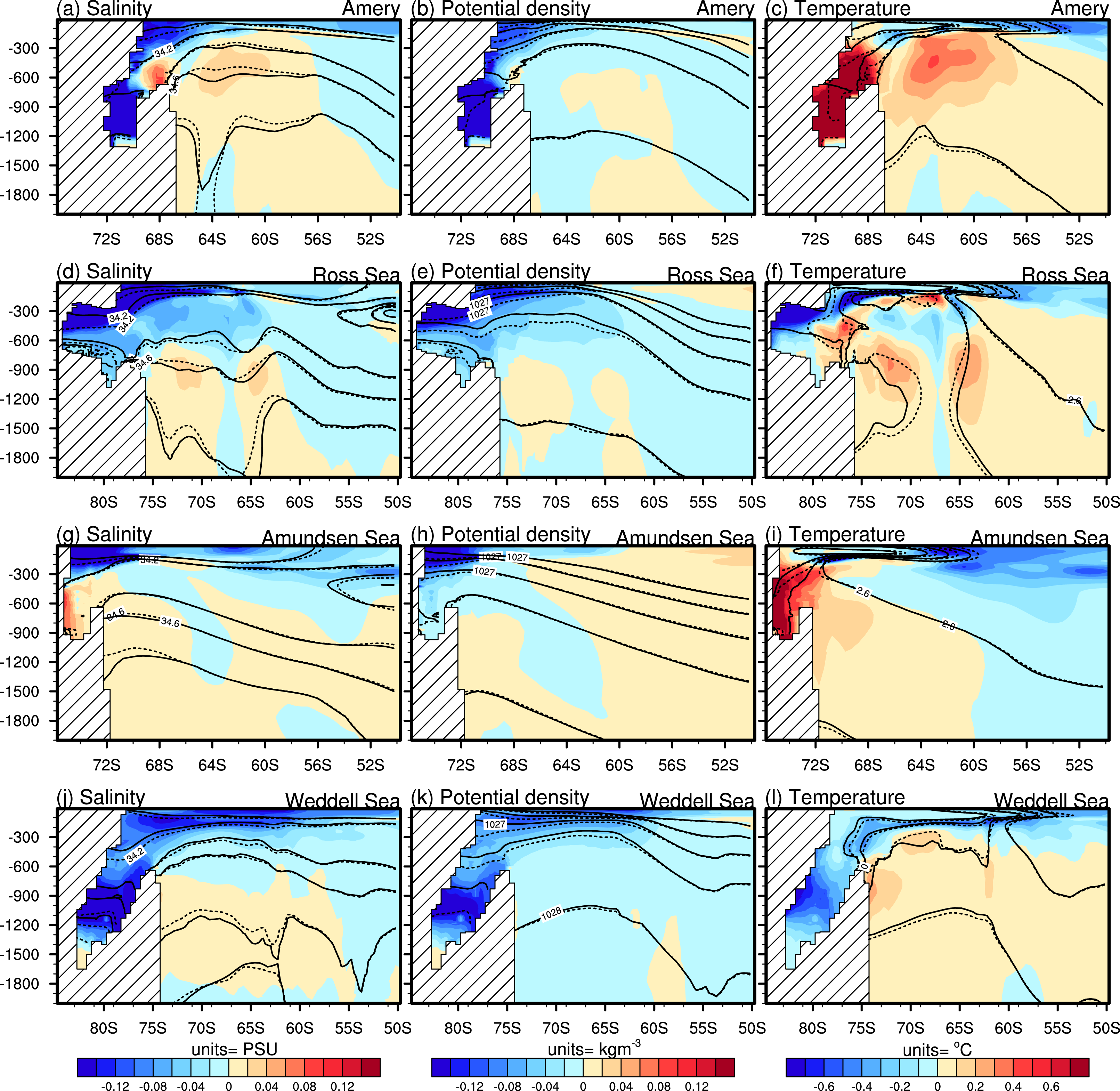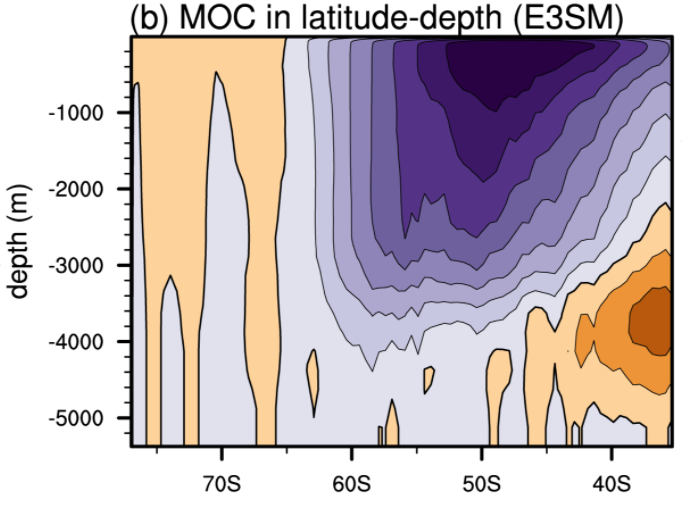Impacts of Ice-Shelf Melting on Water Mass Transformation in the Southern Ocean
 Exploring the potential impacts of explicitly resolved ice-shelf melt fluxes on Southern Ocean sea ice and ocean processes.
Exploring the potential impacts of explicitly resolved ice-shelf melt fluxes on Southern Ocean sea ice and ocean processes.
The Science
The Southern Ocean overturning circulation is driven by winds, heat fluxes, and freshwater sources. Among the sources of freshwater, Antarctic sea ice formation and melting play the dominant role. Even though ice-shelf melt is relatively small in magnitude, it is located close to regions of convection, where it may influence dense water formation. In this study, the impacts of ice-shelf melting on Southern Ocean water mass transformation is studied using E3SM simulations conducted with and without the explicit representation of melt fluxes from beneath Antarctic ice shelves
The Impact
Ice-shelf melt fluxes lead to stronger upper ocean stratification, trapping warm intermediate ocean waters at depth. They also lead to increased Antarctic sea ice, similar to recently observed trends, and implying an increased role of sea ice in Southern Ocean overturning circulation. This study demonstrates the usefulness of E3SM for investigating feedbacks between Antarctic ice-shelf melting, sea ice formation and melting, and Southern Ocean overturning and circulation.

Vertical cross sections of differences in zonally averaged (left) salinity, (center) potential density, and (right) ocean temperature between the simulation with ice-shelf melt fluxes (ISM) and control (Ctrl) simulations (ISM − Ctrl) for the Amery Ice Shelf sector (60°–90°E), Ross Sea (165°E–165°W), Amundsen Sea (90°–120°W), and Weddell Sea (60°–30°W). Solid lines are isohalines, isopycnals, or isotherms for the Ctrl simulation, and dashed lines are for the ISM simulation.
Summary
The E3SM’s novel capability of simulating heat and freshwater exchange within ice-shelf cavities has allowed a team of scientists from Los Alamos, Columbia University, and Scripps Institution of Oceanography to explore the potential impacts of explicitly resolved ice-shelf melt fluxes on Southern Ocean sea ice by comparing simulations with and without ice-shelf melt fluxes.
Ice-shelf melting enhances transformation of Upper Circumpolar Deep Water, converting it to lower density values. While the overall differences in Southern Ocean water mass transformation between the two simulations are moderate, freshwater fluxes produced by ice-shelf melting have a further, indirect impact on the Southern Ocean overturning circulation through their interaction with sea ice formation and melting, which also cause considerable upwelling. The scientists’ findings show that surface water freshening and cooling by ice-shelf melting causes increased Antarctic sea ice production and stronger density stratification near the Antarctic coast. In addition, ice-shelf melting causes decreasing air temperature, which may be directly related to sea ice expansion. The increased stratification reduces vertical heat transport from the deeper ocean. Although the addition of ice-shelf melting processes leads to no significant changes in Southern Ocean WMT, the simulations, and analysis conducted here point to a relationship between increased Antarctic ice-shelf melting and the increased role of sea ice in the Southern Ocean overturning.

Differences between the simulation with ice-shelf melt fluxes (ISM) and control (Ctrl) simulation (ISM − Ctrl) in (a) annual mean sea ice concentration, (b) sea ice thickness, and (c) freshwater flux from sea ice freezing. For freshwater flux by sea ice formation [in (c)], negative values represent more sea ice freezing and positive values mean less sea ice freezing. Area-averaged values for each field are displayed in the middle of each plot. The crosshatched area represents nonsignificant differences at the 95% confidence level from a Student’s t test.
Publication
- Jeong, H, X Asay-Davis, A Turner, D Comeau, S Price, R Abernathey, M Veneziani, et al. 2020. “Impacts of Ice-Shelf Melting on Water Mass Transformation in the Southern Ocean from E3SM Simulations.” Journal of Climate. https://doi.org/10.1175/jcli-d-19-0683.1.
Funding
- The U.S. Department of Energy Office of Science, Biological and Environmental Research supported this research as part of the Earth System Modeling Program Area through the Energy Exascale Earth System Model (E3SM) project.
Contact
- Xylar Asay-Davis, Los Alamos National Laboratory



